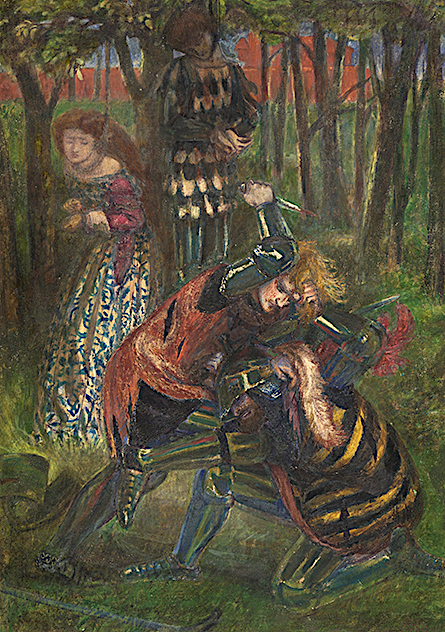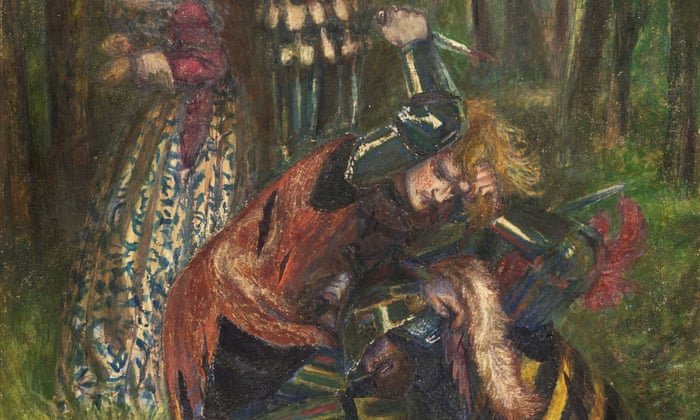
Lost Rossetti painting goes on display at British Museum
The dark Death of Breuze Sans Pitié is from the collection of the late art historian John ChristianMark Brown
The Guardian
Mon 2 Sep 2019
A darker, shocking side of a pre-Raphaelite giant usually known for sensual images of beauty and desire will be seen this week when a once lost painting goes on display at the British Museum.
Dante Gabriel Rossetti’s The Death of Breuze Sans Pitié has hardly ever been seen in public since it was painted in the late 1850s, and was for decades only known from written descriptions.
It is a star of a large private collection built up by the late art historian John Christian, one recently allocated to the British Museum after it was offered to the nation as part of the acceptance in lieu scheme, which allows people to offer artworks and collections to offset inheritance tax.
The startling watercolour shows two knights of Arthurian legend, Dinadan and Breuze, in a knife fight. Behind them is a dead man hanging from a tree and a terrified woman being held against her will with a halter around her neck.
“It is quite different from what we’ve come to expect from Rossetti,” said Susannah Walker, the exhibition’s curator at the British Museum. “We expect lovers and beautiful women, a very dreamy aesthetic. This is a very unusual painting.”
The work was one of seven medieval-inspired watercolours bought by Rossetti’s friend William Morris in the late 1850s.
Morris later sold them, and five finally ended up in the Tate collection. Those watercolours – romantic visions of a chivalric world such as The Blue Closet and The Tune of the Seven Towers – are much more what you would expect a Rossetti to be.
Probably because it was so different and jarring, The Death of St Breuze went its own separate way. It is recorded as part of an auction in New York in 1926 and was then essentially lost to the art world – there were no photographs of it – until it appeared at auction in London in 1993.
It is a fascinating painting because it is so different. A rare description of it is in an 1899 book by HC Marillier, who called it “one of the crudest and least successful of all Rossetti’s water-colours”.

The grim scene, he continued had a “repulsive and unpleasant effect” and the composition was “grotesque and strained”.
It is also mentioned by Rossetti’s brother William in a biography of the artist published in 1889. He writes that Rossetti found The Death of Breuze “a ‘tough job,’ and opined that it ought to have been managed with less labour”.
Walker said it was not straightforward to make out what was going on. “It is an image you really have to stand back from in order to decipher the action. It is not immediate and it is not what you expect from Rossetti, but it is an object which really grows on you.”
The work is one of 900 objects in the collection of Christian, a leading authority on Victorian art who championed the pre-Raphaelites in the 1960s and 1970s when they were out of fashion and their stock was low.
He is particularly known for curating an important Edward Burne-Jones exhibition at the Hayward Gallery in 1976 and a show called The Last Romantics at the Barbican in 1989.
The Rossetti will be part of a small display at the museum, opening on Tuesday, showing highlights of the collection, including drawings by Charles Haslewood Shannon, Benjamin Robert Haydon, Dorothy Hawksley and Kalman Kemeny.
Walker said: “It is a major acquisition offering a huge insight into Victorian art and is a real treasure trove for anyone who wants to learn more deeply about printmaking and drawing and honing the craft of drawing.”
Mon 2 Sep 2019
A darker, shocking side of a pre-Raphaelite giant usually known for sensual images of beauty and desire will be seen this week when a once lost painting goes on display at the British Museum.
Dante Gabriel Rossetti’s The Death of Breuze Sans Pitié has hardly ever been seen in public since it was painted in the late 1850s, and was for decades only known from written descriptions.
It is a star of a large private collection built up by the late art historian John Christian, one recently allocated to the British Museum after it was offered to the nation as part of the acceptance in lieu scheme, which allows people to offer artworks and collections to offset inheritance tax.
The startling watercolour shows two knights of Arthurian legend, Dinadan and Breuze, in a knife fight. Behind them is a dead man hanging from a tree and a terrified woman being held against her will with a halter around her neck.
“It is quite different from what we’ve come to expect from Rossetti,” said Susannah Walker, the exhibition’s curator at the British Museum. “We expect lovers and beautiful women, a very dreamy aesthetic. This is a very unusual painting.”
The work was one of seven medieval-inspired watercolours bought by Rossetti’s friend William Morris in the late 1850s.
Morris later sold them, and five finally ended up in the Tate collection. Those watercolours – romantic visions of a chivalric world such as The Blue Closet and The Tune of the Seven Towers – are much more what you would expect a Rossetti to be.
Probably because it was so different and jarring, The Death of St Breuze went its own separate way. It is recorded as part of an auction in New York in 1926 and was then essentially lost to the art world – there were no photographs of it – until it appeared at auction in London in 1993.
It is a fascinating painting because it is so different. A rare description of it is in an 1899 book by HC Marillier, who called it “one of the crudest and least successful of all Rossetti’s water-colours”.

The grim scene, he continued had a “repulsive and unpleasant effect” and the composition was “grotesque and strained”.
It is also mentioned by Rossetti’s brother William in a biography of the artist published in 1889. He writes that Rossetti found The Death of Breuze “a ‘tough job,’ and opined that it ought to have been managed with less labour”.
Walker said it was not straightforward to make out what was going on. “It is an image you really have to stand back from in order to decipher the action. It is not immediate and it is not what you expect from Rossetti, but it is an object which really grows on you.”
The work is one of 900 objects in the collection of Christian, a leading authority on Victorian art who championed the pre-Raphaelites in the 1960s and 1970s when they were out of fashion and their stock was low.
He is particularly known for curating an important Edward Burne-Jones exhibition at the Hayward Gallery in 1976 and a show called The Last Romantics at the Barbican in 1989.
The Rossetti will be part of a small display at the museum, opening on Tuesday, showing highlights of the collection, including drawings by Charles Haslewood Shannon, Benjamin Robert Haydon, Dorothy Hawksley and Kalman Kemeny.
Walker said: “It is a major acquisition offering a huge insight into Victorian art and is a real treasure trove for anyone who wants to learn more deeply about printmaking and drawing and honing the craft of drawing.”









No comments:
Post a Comment